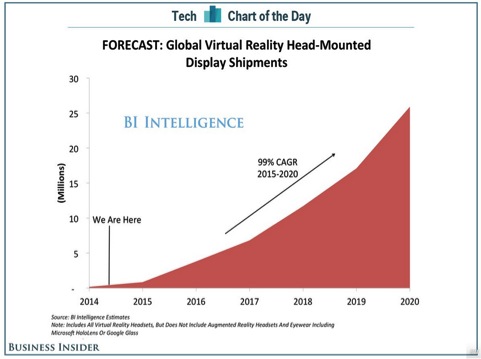The rise and power of virtual reality (VR) has not gone unnoticed by today’s technology giants. With the purchase of Oculus VR for $2 billion in March of 2014, Facebook effectively ushered in an era many knew was rapidly approaching.
Facebook along with Microsoft are enabling VR headsets to connect directly to your computer in their next Windows 10 release, meaning that VR will be accessible to all, and because of this, the marketing world is going to experience a major shift.
Today, Oculus & Facebook, HTC, Samsung, Microsoft, and Google are creating VR headsets and are all competing for market share on the next universal piece of hardware that consumers will have in their homes. These VR headsets will completely revolutionize the way we consume content.
The Power of VR
In the past decade we have seen a proliferation of web content through text, photos, and videos, with over 300 hours being uploaded to YouTube daily, and now, the next big shift is toward 360˚ video & VR.
Photos can only capture a moment in time, video can capture a period of time through one lens, but 360˚ video & VR can capture entire experiences and bring them to life. The ability to capture an atmosphere and a feeling is where VR’s true power lies.
2015’s Virtual Reality Marketing: Developers Only
In the 2015 world of virtual reality, brands are contracting developers to create tradeshow experiences that can truly amaze customers and immersive them into experiences that were never before possible.
(Above is Nissan’s VR Chase the Thrill Experience)
Since consumers can’t easily access the technology, the experiences are incredible simply due to its rarity. As anyone who has used the Oculus can confirm, it’s unlike any other experience in the world.
Overall, brands are gaining a massive viral effect from campaigns through social media, an unmatched amount of press attention, and are gaining an association of being a “tech-forward” and “innovative” company.
2016+ Virtual Reality Marketing: Consumer Edition
In 2016 we will see the consumer versions of VR displays and a greater amount of VR experiences distributed across the Internet. Brands will be coming on board to create experiences that immerse viewers through this new form of content and will start to focus less on ads that cannot match this new level of engagement. 2016 will be the start of a new era in ads.
Early on, gamers will be the early adopters of this technology but as more mass consumer-oriented content is created people will buy VR displays not only because of their novelty, but their sheer power in providing once in a life time experiences with the click of a button.
Any experiences that brands would want to convey to its customers can now be created either through computer generated 3D content or with 360˚ cameras. People will no longer need to leave their homes to truly experience a product or service in 2016!
Release Dates
Samsung is leading the mobile VR push with their Gear VR headset that is available for purchase in stores today and Facebook & Microsoft will be first to the consumer PC market with their Oculus Rift display available for purchase in retail outlets in spring 2016. A VR world is just around the corner.

